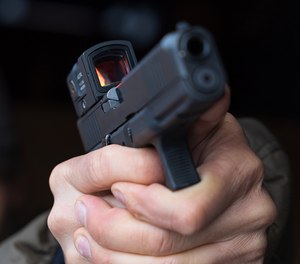Content provided by Rampart USA
Thank you for reading this post, don't forget to follow and signup for notifications!
Miniature red dot sights (MRDS) on pistols are quickly being adopted by forward-thinking law enforcement agencies who are discovering the range of benefits offered by adding an optic to a duty pistol. As more data is published, mounting evidence clearly shows that MRDS enhance the safety and accuracy of law enforcement pistols, improve situational awareness and are more effective when used in high-stress situations.
MRDS have been used by special operations forces, tactical teams and in competitive shooting sports for years. Now, with further advancements in durability, battery life, duty holster compatibility and OEM duty pistol compatibility, MRDS have quickly become a viable option for general duty use. As more agencies begin to adopt MRDS optics, the true benefits to usability and police user safety are becoming very apparent.


REACTING TO STRESS
When the human body is subject to stress, the sympathetic nervous system (SNS) initiates a variety of responses that prime the body to defend itself or escape danger. One of the first activations by SNS is to the eyes. Our field of vision is increased to its maximum, pupils are dilated to intake more visual information, and the ciliary muscles (the ring of muscles that surround the lens of the eye) contract, which thickens the lens for better distant focus.
This reaction has served a critical role in mankind’s survival throughout history, but when operating a firearm, it can make it extremely difficult to find your sights and acquire sight picture under extreme stress or spontaneous threat. [1] When using an MRDS, your eyes can remain in a more natural and open state, which allows for less reliance on fine focus, ultimately better compensating for these involuntary physiological changes. The wider and clearer target picture allows for a much easier sight to acquire under stress.
CHANGES IN THE BRAIN
Predictably, the human brain also has its own reaction to a stress response triggered by our SNS. Under extreme stress, our brain modifies the way it takes in information. Specifically, it prioritizes the volume of information taken in over the accuracy of the information taken in. [2]
Under high stress, our brain cannot process as much detail in the visual data it takes in, which can cause the mind to make presumptive leaps, or “fill in the blanks”. [3] This is especially true in low light scenarios. [4]
The human brain can incorrectly complete a pattern or misinterpret an object, like mistaking a floor lamp for a person, or a cellphone for a pistol. This can present an extremely dangerous scenario where police users can make a “mistake-of-fact shooting,” where the police user makes an honest mistake where they believed that the use of lethal force was justified.
MRDS, with their wider focal plane and bright powered red dot, allow the police user to greatly increase the amount of information they can take in about their surroundings while retaining sight picture. This additional situational awareness can mitigate some of the presumptive thinking our brains are prone to under extreme stress. In moments where quick decisions need to be made, having additional visual data available to the police user can help make better, more informed decisions and improve both situational awareness and accuracy under stress.
These are just some of the ways MRDS can help police better protect the public with technology. As more and more agencies adopt MRDS, and as more data is released, the benefits of an MRDS for both public and police user safety are becoming common knowledge. Their improvements in accuracy, benefits to situational awareness and better compensation to our physiological responses to stress present a clear advantage over traditional pistol iron sights.
MRDS have already been adopted by many agencies across the United States to great effect. Similarly, agencies are also converting to modular optic system pistols in the event they choose to adopt MRDS in the future.
WHY YOUR AGENCY SHOULD CONSIDER MRDS FOR GENERAL DUTY POLICING
- Faster and more accurate target detection.
- Improved target detection under stress.
- Greatly improved situational awareness.
- More accurate follow-up shots.
- More accurate shots on moving targets.
- Improved low light accuracy.
- Greater accuracy for aging police users or those with vision issues.
When it comes to miniature red dot sights, Rampart USA recommends the Acro P-2 from Aimpoint, the world leader in red dot sighting technology. The new Acro P-2 incorporates an improved LED emitter with a much higher capacity battery that provides an astonishing 5-year constant on battery life. Built to withstand extreme temperatures, shock and vibration, the Acro P-2 sets the standard for professional-grade, fully enclosed systems.
To learn more about Aimpoint products and source the best product for your agency, contact Rampart USA.
REFERENCES
1. Autonomic Nervous System, Flinders University, Australia Dr. Bill Blessing, Dr. Ian Gibbins (2011), The Integrative Action of the Autonomic Nervous System: Neurobiology of Homeostasis, Dr. W.W. J?nig, Cambridge University (2006)
2. Amodal Completion, Perception and Visual Imagery, Clotilde Calabi, Interpolation and extrapolation in human behavior and neural networks, J Cogn Neurosci. (2004)
3. Heuristics, servants to intuition, in clinical decision making, Jane Cioffi (1997)
4. Officer-Involved Shootings: What We Didn’t Know Has Hurt Us, Thomas J. Aveni, M.S. (2003)



